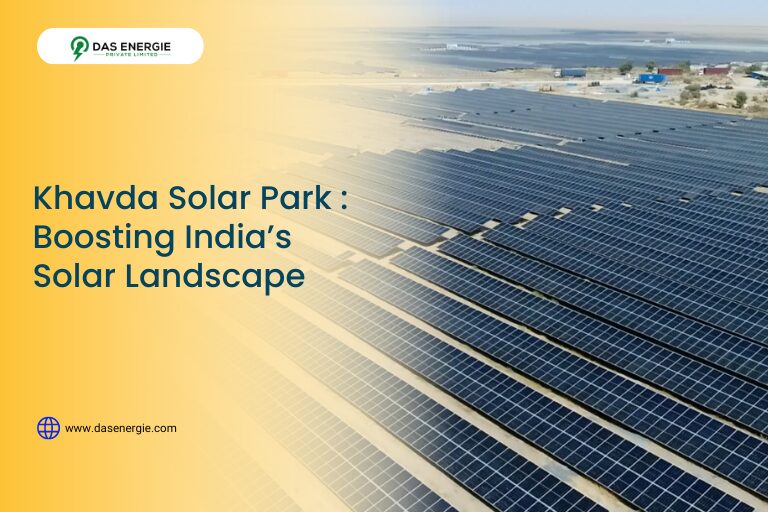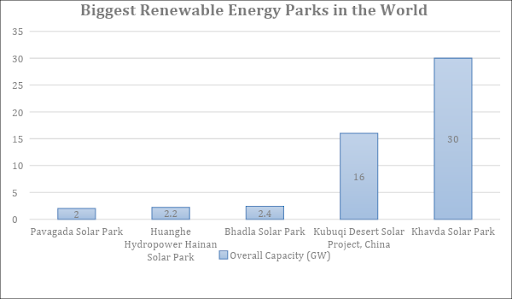


Imagine a vast sunny landscape filled with millions of solar panels glistening in the desert sunshine. This isn’t a futuristic vision; it’s the very real Khavda Solar Park. Also known as the Gujarat Hybrid Renewable Energy Park, the project costs approximately 1.5 lakh crore and is of a staggering size similar to the city of Bangalore!
This is going to be the largest renewable energy park in the world, with a planned capacity of 30 GW.
The Hybrid park will offset approximately 58 million tonnes of CO2 per year. It also aims to provide clean energy to around 16 million homes, which is nearly comparable to powering entire countries like Poland, Belgium and Canada.
Table of Contents
ToggleOne of the most innovative aspects of the Khavda Solar Park is its marriage of solar and wind power. Solar power generation peaks during the day, while wind power can be harnessed all the time and in different weather conditions. Below is a breakdown:
Capacity: 26 GW.
Total Land: 49,600 hectares.
Developers | Allocated Land | Overall Permitted Capacity |
Adani Green Energy (AGEL) | 19,000 hectares | 9.5 GW |
Sarjan Realities | 9,500 hectares | 4.75 GW |
NTPC | 9,500 hectares | 4.75 GW |
Gujarat Industries Power Company (GIPCL) | 4,750 hectares | 2.37 GW |
Gujarat State Electricity Corporation | 6,650 hectares | 3.32 GW |

Capacity: 4,000 MW.
Total Land: 23,000 hectares.
Developers: | Solar Energy Corporation of India will invite competitive bidding. |
Management: | The Power Grid Corporation of India will manage the electric power transmission. |
Watch the YouTube video on Khavda Solar Park:
The Khavda Solar Park is built near Vighakot village in the Kutch district, strategically placed approximately 10 kilometres from the India-Pakistan border.
Khavda Solar Park location is strategically chosen to maximise its potential. The positioning offers several benefits:
It is crucial to have a professional and skilled vendor to install your solar system. Das Energie Private Limited provides quotations from DISCOM-empanelled vendors near you. We have thoroughly vetted and onboarded vendors.

This detailed Khavda Solar Park map provides a comprehensive layout of the park’s vast infrastructure and planned installations.
The Khavda Solar Park is at the forefront of technological innovation in the renewable energy sector. Several cutting-edge technologies are being employed for the first time in the country to enhance the efficiency of the park:

The Khavda renewable project has made significant strides in its development with several key milestones. The following table provides a detailed breakdown of the project phases, key players and the current status:
Phase | Details | Timeline |
Project Initiation and Approval | The government of Gujarat approves the Khavda Solar Park project. | September 2020 |
Indian Prime Minister Narendra Modi lays the foundation stone. | December 2020 | |
Phase 1: Initial Development | NTPC REL secures 4.75 GW Solar Park project approval. | July 2021 |
GSECL RE Park Ph-I: 3.32 GW capacity approval. | August 2021 | |
Land acquisition for NTPC REL: 23,750 acres completed. | May 2022 | |
Initial groundwork, including the construction of a 30-km access road. | 2021-2023 | |
Adani Green Energy Limited (AGEL) commissions the first 1 GW capacity. | March 2023 | |
Phase 2: Scaling Up Capacity | GIPCL begins construction on an additional 600 MW capacity. | May 2023 |
GIPCL RE Park Ph-II: 1.2 GW capacity, contracts awarded for infrastructure. | July 2023 | |
GIPCL RE Park Ph-III: 575 MW capacity, contracts awarded for infrastructure. | July 2023 | |
AGEL secured funding for constructing an additional 2.1 GW capacity. | December 2023 | |
GSECL RE Park is expected to achieve 1.6 GW of the total planned capacity. | 2024 | |
NHPC bags a 200 MW solar project | March 2024 | |
Expected to achieve 50% of the total planned capacity. | December 2024 | |
Future Developments | The NHPC project is expected to generate about 473 million units in the first year and a cumulative generation of 10,850 million units over 25 years. | 2025-2026 |
The Khavda Solar Park capacity is projected to reach 30 GW at full completion. | December 2026 |
Operationalising of the first 1 GW by AGEL, with the installation of 2.4 million photovoltaic modules.
The Khavda RE Park contributes substantially in multiple ways:
In the realm of renewable energy projects, the Khavda Solar Park in India stands out as a true giant. Its sheer scale and innovative hybrid approach to harnessing both solar and wind power set it apart from the competition.
The largest renewable energy park around the world:

The closest contender might be China’s Kubuqi Desert Solar Project expected to supply 40 TWh/year. However, Kubuqi incorporates coal energy in its mix, a point of distinction from Khavda’s pure focus on renewables. While both Khavda and Kubuqi are still under construction, the 30 GW capacity of the Gujarat Hybrid RE Park will surpass all currently operational solar parks globally.
The Khavda Solar Park or Gujarat Hybrid Renewable Energy Park is a significant milestone in India’s renewable energy journey. From its strategic location to its innovative integration of solar and wind power, Khavda Solar Park is a marvel of modern engineering. The park’s potential to generate clean energy for millions of homes while creating a substantial number of green jobs positions it as a game-changer.
The impact of the Khavda Solar Project goes beyond India’s borders. By reducing reliance on fossil fuels and curbing carbon emissions, this colossal project sets a powerful example for the world. It’s a blueprint for a future powered by clean energy, paving the way for a more sustainable planet.
While most of the project is expected to be completed by 2026, Adani Green expects to finish it within the next five years.
In regions with frequent sandstorms, it’s important to find innovative cleaning solutions to maintain infrastructure and keep surfaces clear of sand and dust. Additionally, high ambient temperatures in these areas can potentially impact the efficiency of solar panels. Limited water resources further pose a challenge for cleaning and construction purposes in these environments.
The park will be connected to existing power transmission lines facilitated by the Power Grid Corporation of India (PGCIL). Upgrading existing infrastructure might be required to handle the massive amount of energy generated with plans of 14 GWh by the Indian government.
Environmental impact assessments are often conducted to minimise the disruption of wildlife habitats. One method used to prevent collisions with solar panels is the use of bird deterrents.
The project aims to create jobs in the construction, maintenance, and security sectors. It also has the potential to incorporate skill development programs in renewable energy, and it seeks to improve access to clean energy for nearby villages.
Mr Das’ expertise spans various aspects of solar energy, including photovoltaic technology, solar thermal systems, and energy storage solutions. He contributes profusely to our blogs to share his keen knowledge and expertise with those seeking information regarding solar system installation. He brings a wealth of practical knowledge and real-world experience to his writing. His articles offer valuable guidance on navigating the intricacies of solar energy projects, from site assessment and system sizing to financing options and maintenance strategies.

7 Comments
Nitin
Thanks for the informative blog
Tarun Kumar Das
Thanks for your comment.
Satyam Negi
It is a highly informative blog. I learned so much from it! India is already a world leader in solar power.
Tarun Kumar Das
Thanks for reaching out. Go through our blog section to get more informative blogs on solar.
Vikas Shaw
It really clears up all the confusion around the Khavda Solar Park. However, it looks unlikely to finish before 2026. great tables.
Aloke
A great information indeed regarding khavda solar park.Every details are very important and the blogg is very very helpful .
Turna Das
The Khavda Solar Park Research project is surely an impressive initiative, showcasing advancement in renewable energy. It’s innovative approach and large scale implementation highlights a commendable commitment to sustainable development.
Indeed a great research done.